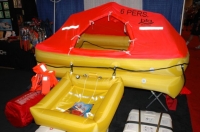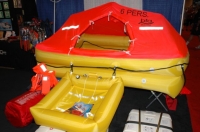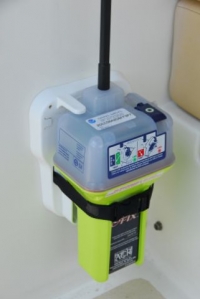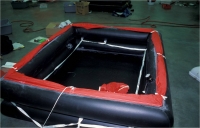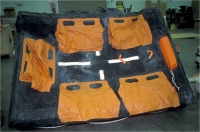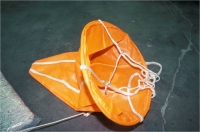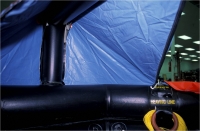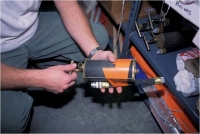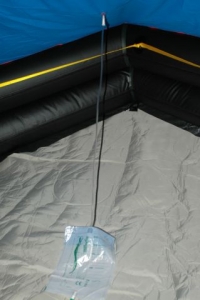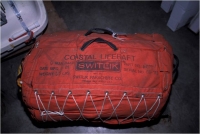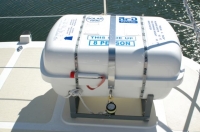Recently, an SDMC consulting client who is in the process of having a 68-foot cruising vessel built, contacted me. He posed several important questions regarding the placement and installation of a life raft aboard his new vessel. The original questions prompted an exchange that led me to believe that a more thorough discussion on the subject would benefit both him and SDMC blog subscribers.
Life rafts are a subject of great interest to me; I’ve studied, tested and written about them on many occasions. The initial question I’m often asked when meeting with clients or lecture attendees is, “do I really need a life raft?” The answer often surprises cruisers, both power and sail alike. It goes something like this…”Have you ever spent any time in the water, hopefully with a life jacket, possibly out of sight of land, possibly in water that will cause you to become hypothermic (that’s warmer than you think, anything less than about 70°F, and sometimes warmer depending upon the individual) wondering if anyone knows you are in distress or where you are?” If the answer is no, then it’s tough justify saying no to a life raft. Even vessels that never leave sight of land benefit from this “life insurance package”. Of course not all rafts are created equal and small, simple rafts are often adequate for inshore cruising vessels. Larger, more capable rafts, sometimes referred to as “survival platforms”, are easily justifiable for vessels that venture into blue water.
During the lectures I present at the Safety at Sea conference held each year at the US Naval Academy I participate in life raft demonstrations and “test firings”. During these educational events for cruisers, the opportunity is afforded for actual raft time. That is, you can deploy and board a life raft in a controlled swimming pool environment. It’s often an enlightening experience for those who partake, rafts are always smaller and less stable than you think, they are difficult to board and they are very adept at inducing seasickness. Once having taken part in this exercise I have no doubt you will think twice when considering the perceived “safety” of a life raft over a vessel that remains afloat (more on that philosophy below).
I strongly recommend that you take advantage of one of these sessions. For a listing of upcoming events visit http://offshore.ussailing.org/SAS/Seminars/SAS_Calendar.htm While the emphasis of these events is on sailing, the life raft demonstrations and fully 75% of the remainder of the information imparted is equally valuable to both power and sail cruisers. Additionally, life raft demonstrations are carried out at nearly every Trawler Fest event, for more on those visithttp://www.passagemaker.com/MagazineandEvents/TrawlerFest/LocationsDates/tabid/342/Default.aspx . This blog entry is a rather long one; however, I believe the subject warrants the additional coverage, I hope you find Part I of the discussion useful.
Life Raft Essentials
In June of 2001, Rick and Linda Porter, sailing their 32-foot cutter Leviathan, were in the midst of crossing a remote section of the Western Indian Ocean. No one knows for sure, but at some point, it seems the crew got into trouble, which was probably weather induced. Their final SSB communication indicated that they were making way through heavy seas and high winds, but were not in need of assistance. Seven hours later several RCC’s (rescue coordination centers) recorded a signal broadcast from Leviathan’s EPIRB, a category I 406 unit equipped with hydrostatic release. The remainder of the story is a muddled mix of bureaucratic mix-ups and poor communication between those who knew about the distress signal and those who could actually go out and search. Leviathan’s EPIRB signal was received for a mere six hours before ceasing. Neither Leviathan nor her crew have been heard from since, no wreckage, debris or flotsam has been found that can be connected with the either the Porters or their boat. Leviathan had an inflatable dinghy, but no life raft.
Manually and automatically deployed EPIRBs, left and right respectively.
Before entering into a discussion about life rafts, their construction and use, some comment on search and rescue is in order. The primary acronymed players in the search and rescue field are SARSAT/COSPAS (Search and Rescue Satellite-Aided Tracking and Cosmichkaya Sistema Poiska Avariynich Sudov, which translates as Space System for Search of Vessels in Distress) and AMVER (Automated Mutual-Assistance Vessel Response System). The former comprises the electronic assets that listen for EPIRB signals and the latter are the vessels that might actually pop over the horizon and come to your aid.
AMVER is administered by the USCG and is tantamount to volunteer fire brigade, commercial, government and military vessels that go about their business on the high seas every day that have agreed to tell the AMVER coordination center where they will be if needed. When you call for help chances are good, particularly when well off shore, that a freighter, tanker, war or cruise ship will, thanks to AMVER, come to your aid rather than a dedicated search and rescue craft and it will probably happen a lot more quickly.
Keep in mind, however, that the AMVER system far from guarantees your rescue. There may be no cooperating vessels in your area, their communication gear may be malfunctioning, or they may be unable to find you in poor visibility. Remember, these are volunteers and, unless it’s a military vessel, the crews are not professional SAR folks and they are under no obligation to risk their lives to save you.
Although you may feel less than lucky at the time, it is also important to remember that if you find yourself in extremis within 300 nm of the coast of the continental US, you are fortunate indeed. Between Coast Guard, Air National Guard, Navy and other military organizations, not to mention the volume of commercial traffic, North America is among the best locations for SAR assets.
Give careful consideration to abandoning your vessel. There’s an old safety at sea axiom, don’t get into the life raft until you have to step up into it, that rings especially true. Your vessel, as long as it’s afloat and not in flames, is better than any life raft.
It is equally important to note that if you intend to cruise beyond this “back yard” safety net, you are further from organized, efficient and well-equipped assistance, as the Leviathan’s crew was unfortunate enough to discover. Self-reliance will play a much larger, perhaps even a dominant, role in your survival. The watch words are, choose your gear accordingly. Within the 300 nm limit, short-term survival duration, while not assured, is much more likely. This, as opposed to trackless stretches of the Indian, Pacific or Southern Oceans, is where people, planes and ships are plentiful. It is more likely that, when cruising in these less populated regions (which is why they are among the best cruising grounds) that may be remote from SAR assets, life raft stays may be measured in weeks rather than days or hours.
Life Raft History 101
Many folks have been fortunate to survive extended stays in inflatable life rafts. History has shown us that it is possible to exist under less than ideal conditions while floating on the sea in little more than an airtight (for the most part) rubber bag.
During WWII, the Good Year Rubber Co. supplied thousands of life rafts to the military for use by aviators who were forced to ditch at sea. Eddie Rickenbacker and the 7-man crew of a B-17 in which he was a passenger, survived for 21 days in three small rafts, with only one fatality. Chief Petty Officer Harold Dixon and his two-man US Navy patrol aircraft crew survived 34 days in a single 8-foot raft (this raft can be seen at the Pensacola Naval Air Museum).
More recently, Dougal Robertson’s family and the crew of Lucette, six in all, survived for 37 days in a ten-man raft after being attacked by a pod of orcas. Notably, however, the raft disintegrated after 17 days and they were all forced to move to a 9-foot fiberglass dinghy. The Butlers, two people, spent 66 days in a 4-person coastal raft and Steve Callahan, sailing alone from the Canary Islands to the Caribbean sank while approximately 1,800 miles from landfall. He endured an astounding two and a half months in a 6-man raft. .
The final and perhaps most amazing entry in this hit parade of raft survivors is that of Maurice and Maralyn Bailey, again two in a four-man raft, who survived 117 days (a record) after also being attacked by orcas. The Baileys were fortunate to have with them, in addition to their life raft, a 9-foot Zodiac-type inflatable, which they put to good use, as did the Robertsons, as an abattoir.
This list of life raft survivors is by no means complete; there have been others. It does, however, make two points amply clear. One, if properly equipped, both physically (body and equipment) and emotionally, occupants may be expected to survive long-term life raft events. Two, we cannot benefit from the experiences of those who did not survive. There’s no way to know what they did wrong or what ultimately led to their demise, we only know what the above detailed individuals did to sustain themselves.
A life raft is easily spotted in a vast blue sea when compared to the soccer ball-size head of a floating person.
Raft Guidelines
A dizzying array of organizations weigh in with guidelines and requirements for life raft applications, construction and deployment, the US Coast Guard, SOLAS (The International Convention for the Safety of Life at Sea) and ISAF (International Sailing Federation), ORC (Offshore Racing Council) to name a few. It is vitally important to note, however, that non-inspected vessels, essentially those that are not commercial in nature, are completely unregulated where life rafts are concerned. Into this category fall cruising power and sail vessels. There are essentially no mandatory guidelines governing the construction or use of life rafts for cruisers. The manner in which the raft is fabricated, the materials used, space per occupant, contents etc. are entirely at the discretion of the manufacturer, where non-inspected vessels are concerned.
This cloud is, however, not entirely without a silver lining. The above-mentioned organizations, ISAF and USCG, do provide voluminous details and recommendations for construction of “yachtsman’s” life rafts, i.e. those that will be used on non-inspected vessels. Racing organizations, such as ISAF, usually mandate specific raft features and deployment capabilities as a prerequisite for participation in certain offshore and ocean races. As a result, even the humble cruiser is capable of ascertaining which raft is right for its intended use.
SOLAS approved life rafts are often considered the cream of the cream. These rafts are destined for commercial use on merchant ships and passenger vessels or must meet the exacting standards for this type of use. There is little room for interpretation by their manufacturers; their size, construction and contents are rigidly prescribed. This is particularly true for the “contents” or survival package.
A 6 person SOLAS approved raft must, for example, carry 4 parachute rocket signals, 6 hand flares, 2 smoke signals, a signal mirror and 9.5 liters of drinking water, among many other items. A randomly selected, leading brand “offshore” 6-person raft, conversely, includes three hand flares, no signal mirror and no water. As this example illustrates, the “buyer beware” axiom truly applies to life raft selection.
The primary caveat in selecting a SOLAS approved raft is bulk. In order to meet all of the guidelines and standards they are often large and heavy. They are also, as might be expected, usually more expensive than their non-SOLAS approved brethren.
Does this mean all non-SOLAS compliant rafts are inadequate? The answer to that question must be a resounding NO. Several manufacturers offer excellent rafts that do not meet all of the SOLAS guidelines. They are invariably smaller, lighter and less expensive than SOLAS rafts. A primary obstacle to SOLAS approval is capacity. SOLAS compliant rafts may accommodate no less than six persons. Therefore, a 4-person raft may be SOLAS compliant in all respects save this one.
USCG approved rafts are designed to meet regulations and laws that specifically apply to United States flagged commercial and passenger carrying vessels. USCG approved rafts are similar to SOLAS rafts; however, there may be subtle differences between the two. Most SOLAS rafts are also USCG approved while many USCG approved rafts are not SOLAS compliant.
Beware of the occasional life raft advertisement that uses words like, “equipped with SOLAS approved parachute flares” or “SOLAS approved double buoyancy tubes”. These rafts may not, and probably are not, fully SOLAS compliant. Various components and features may fall within the SOLAS approval guidelines, but the entire raft may not meet all the requirements needed for SOLAS compliance. It does not necessarily mean that these rafts are defective or inferior. It simply means that as a whole, the raft does not meet the stringent standards set forth by the Safety of Life at Sea convention.
Life Raft Designation
In order to ensure that life rafts are used for the appropriate purposes, their use has been segregated into three basic categories, coastal, offshore and ocean. Not exceeding the life raft’s design parameters is a critical component in ensuring proper raft performance and longevity. Coastal rafts are designed for extremely short duration stays, from a few hours to a day or two. Offshore rafts are usually designed for four to five day “trips”, while ocean category rafts signify long duration survival situations, lasting up to 30 days. Fortunately, some raft manufacturers do not take these duration guidelines literally and opt to err conservatively. The aforementioned Butler couple survived for 66 days in a Switlik raft designated for coastal use. Fortunately, for them, the manufacturer over-engineered this raft, which enabled it to outlive its design duration by a considerable margin.
An offshore raft, shown above, includes a variety of features that improve survivability of the occupants who may be aboard for longer duration. Coastal rafts, on the other hand, shown below, while valuable, are simply not designed for extended stays or tumultuous conditions.
The importance of selecting the right raft for the conditions under which it will be used cannot be underestimated. First, determine what your cruising grounds are and will be. Will you venture beyond the “back yard” SAR umbrella? If you are sailing within this, “high probability of quick rescue” region, you may opt for a coastal or off shore raft rather than an ocean model and use the money you’ve saved to purchase a second EPIRB and anti-exposure suite (the latter may be invaluable when sailing in cooler waters). The standard EPIRB battery is designed to allow the transmitter to operate for 48 hours (there is no guarantee the unit will operate for a full 48 hours, as the Leviathan episode illustrated). A second EPIRB will offer redundancy, in the event EPIRB number one fails to function or is lost. A second EPIRB will also double transmit time (provided they are used consecutively); allowing rescuers to zero in on your location, particularly in less than ideal weather conditions when SAR assets may be limited in their ability to travel.
What type of weather conditions will you experience during all phases of your passage(s)? It is worth noting; all of the previously mentioned survivors met with disaster in tropical or subtropical latitudes. Battling constant hypothermia, while experienced to some degree by nearly all life raft survivors, was not a major factor in their survival. If you are cruising in higher latitudes, then your raft may differ from one used in regions that are more temperate.
Your primary concerns, as the survivor of a vessel that has sunk, are to get out of the water and get warm and obtain fresh drinking water. Achieving these two goals will sustain you for several days, perhaps weeks depending on your condition and the weather. For long term survival you will need to add food to this equation, which will allow your survival period to be extended for many weeks and perhaps months if necessary. The raft you choose must allow you to complete the above “obstacle course” if your goal is long-term survival. If you are willing to put your life in the hands of SARSAT personnel, then you may change your raft requirements from long-term survival to short-term survival.
Raft Features
The only factor that separates one life raft from another is its features; how it’s designed, constructed and equipped. There are a host of details that can be considered critically important, while the list of less important items is, not surprisingly, shorter. In the former category are subjects such as stability, boarding ladders and canopies, while the latter category might encompass interior color and the number of viewing ports.
Clearly, stability is a key factor in keeping life raft occupants alive and uninjured. The accepted standard among most manufacturers is to provide stability, essentially anti-capsize protection, by using ballast bags. These large bags are attached to the bottom of the raft. They fill with water, which makes the raft much more stable than it would be without the benefit of ballast. The shape and size of these bags varies from manufacturer to manufacturer. Some are weighted, which decreases the time it takes for them to fill with water and deploy. This may seem inconsequential, however, it is likely that the raft will be deployed in less than ideal conditions. The quicker the raft becomes a stable platform, the quicker survivors can enter and remain relatively confident that the raft will not capsize.
Ballast bags like the ones shown here fill with water, improving a raft’s stability when wave face angles become especially steep.
There are times where ballast bags can become a liability. In calmer conditions or gentle swells, the motion imparted to the raft by the oversized ballast may actually promote seasickness. Additionally, if the raft’s occupants wish to take advantage of a favorable wind to carry the raft nearer to land or shipping lanes, the ballast bags will hinder this progress. For these reasons, some raft manufacturers have incorporated ballast bag retraction systems that the occupants can use when ballast is undesirable.
Linked with the ballast bags for stability is the drogue. Deployed on the windward side of the raft, the drogue will keep the door down wind while preventing the raft from lifting and, “catching air”. If this does occur, the raft is almost certain to capsize. The drogue must possess certain features to operate most effectively. Primarily, it must be strong enough so that it is not lost in heavy weather. It should also be attached to the raft via a rode that is a minimum of 80 feet in length (short drogue rodes are ineffective on rafts for the same reason they are ineffective on large vessels). Additionally, the drogue should be equipped with a swivel to prevent entanglement and the resultant tripping. Some rafts employ dual entry points, one of which can be used to adjust and monitor the drogue (chafe is an ever present danger on life rafts, particularly at the drogue rode attachment point) as well as providing for cross ventilation in warm, humid conditions. Ideally, the drogue should self deploy. It is not inconceivable that survivors would be unaware of its existence or forget to deploy it because of exhaustion, hypothermia or shock.
Drogues, like the one shown here, are an important part of raft stability. It’s important to understand how they should be used, however.
A proper off shore or ocean life raft must be equipped with a self erecting canopy that will protect the occupants from the elements. Some raft manufacturers rely upon the occupant’s heads to support this canopy. This is better than no protection at all but it is hardly adequate and should never be considered for anything but extremely short-term survival scenarios. Additionally, the canopy should be capable of catching and channeling rain to a collection point within the raft’s interior. The ideal canopy will be made up of two layers of material, brightly colored on the outside and light blue on the inside (light blue has been identified as a soothing color that is less conducive to sea sickness than orange or red). Some raft manufacturers provide integral radar reflective capabilities within the canopy (a SOLAS requirement) and raft bottom. Finally, the canopy should be equipped with water activated lights, one on the outside so survivors may more easily find the raft in darkness and one on the inside so that occupants can orient themselves and unpack and use survival gear.
A canopy can be a life saver, literally, sheltering the occupants from the elements as well as keeping them and vital gear in the raft in the event of a capsize.
Virtually all life rafts employ auto-inflation (make no mistake about it, this is a prerequisite), utilizing a painter that doubles as a trigger. The painter is pulled out of the raft canister or valise until it reaches the inflation trigger, at which point a compressed gas bottle, usually CO2, is opened, filling the raft. Once the raft has inflated, the painter should keep it attached to the vessel until the survivors elect to abandon ship. In anything other than moderate conditions, life rafts and cruising vessels, particularly if they are sinking or burning, should not remain tethered to each other. It is likely that they will have considerably different motion and rates of drift, which may lead to the raft damage.
Other necessary and desirable attributes for quality life rafts include lifelines that surround the raft’s perimeter (inside and out), clearly labeled placards indicating the entry point or points and an easy to use ladder that has a deep, weighted step (some rafts utilize an inflated boarding ramp, which is particularly useful if survivors are injured or hypothermic). Few life rafts are guaranteed to inflate in the upright position and thus the raft must also be easily righted by one person.
Lifelines or straps enable those in the water to hang on to the raft until they can board or in the event they are thrown overboard.
All off shore and ocean rafts must be constructed utilizing the double buoyancy tube design, which ensures redundancy in the event one chamber is holed. The raft should be able to support the entire compliment of survivors in the event one tube deflates. Compartmentalization is critical for life raft design and durability and different manufacturer’s take different approaches to this problem. Some employ check valves to prevent a puncture in one compartment deflating its neighbor, while others utilize an interior self-repairing “sock” that is drawn into the deflating tube. Whichever system is used, a critical component in leak mitigation is the raft’s on board pump. All rafts must include a hand (foot operated pumps are difficult if not impossible to use in life rafts for obvious reasons) operated pump. This pump should be fully assembled, easy and ready to operate, particularly in low light conditions by people whose hands are cold and numb. Because of normal heating and cooling cycles and the consequent venting through overpressure relief ports, the survivors may have to add air to the life raft several times a day, even if there are no leaks. Thus, the pump must be durable and efficient.
A variety of raft pump styles, some clearly easier to use than others. If possible, try out the one your raft is equipped with before you may be forced to use it. If you aren’t happy with the design, you can always replace it with a different style.
A feature that is often overlooked during life raft selection is the design of the floor. Ideally, the floor should be double layered and inflatable. This will provide critical insulation for the survivors, particularly when the seawater is cold. The ability of cold seawater to draw heat from occupant’s bodies should not be underestimated. Additionally, an insulated, double floor provides redundancy in the event one layer is holed and it will offer some protection against “bumping” sea creatures. Nearly every life raft survivor has related the agony and anxiety caused by constant probing by sharks, dorado, turtles etc. An alternative to an inflatable double bottom is a closed-cell foam insert floor. While adequate for insulation (lighter varieties will tear easily), it does not provide the additional buoyancy of an integral inflated floor.
While on the subject of floors, it is worth mentioning that floor space per survivor is regulated in SOLAS and USCG rafts at four sq. ft. per person. If you draw an imaginary 2-foot by 2-foot box on your living room floor, you will quickly realize that this space is quite cramped. Some rafts provide more than the minimum 4 sq. ft. per person and if this is important to you, or if you intend to sail with a crew that matches your raft’s capacity, you may wish to consider over sizing (an eight person raft for a 6 person crew, for instance) or opting for a raft that provides additional space.
Rafts with double lined floors are most desirable, while an insulation layer is also valuable. The latter, however, will offer no additional watertight integrity. Rafts without either of these features should not be used in regions where water temperatures are below 70°F.
Finally, in order to preserve the integrity and security of your raft, so it is fully operational when you need it, it must be contained in a strong, water resistant (this does not mean submersible) container or valise. The debate over rigid container vs. soft valise is one that has existed for quite some time. It can be summarized thusly; hard containers offer maximum durability, protection and ease of deployment at higher expense while valises provide ease of storage (out of thieves reach if necessary) along with a reduction in weight. The valise is also less expensive than the rigid container. You must be the judge. The raft is only as good as your ability to deploy it. If you cannot get it out of the sail locker or lazarette because it’s buried under gear, then it’s of little value.
Valise, left, vs. container, right. Be certain you understand the limitations and requirements for both before making your decision.
Alternatively, if your deck-mounted canister is stolen while in port, it too will be of little use to you in an abandon ship scenario. When mounting options and deck space permit, my preference is for the hard mounted canister. Bear in mind, neither of these containment systems are waterproof. I have observed water damage occur to both canister and valise packed rafts. Canisters are designed for deck mounting, however, if they are subject to foredeck boarding seas, they may be damaged (more on this subject in the raft deployment section).
Contents
An entire article could be written on this subject alone, which is indicative of the importance of this topic. In nearly every account of life raft survival, a reoccurring theme is the astonishment and disappointment experienced by survivors when they discover the inadequacy of the raft survival package.
The USCG and SOLAS requirements are very specific about what must be packed in the raft. These items range from a given number of “SOLAS approved” parachute flares and smoke signals, to quantities of drinking water as well as sponges fishing kits and seasickness bags. The full list of SOLAS/USCG required items is shown in the sidebar and it is important to remember, even if a raft is not fully SOLAS compliant, for one reason or another, its survival package may indeed meet all of the guidelines.
Get to know the contents of your raft before purchasing it or when it’s repacked.
The caveats for raft contents are twofold. One, don’t expect too much as far as the survival pack goes, particularly from coastal rafts. These rafts will almost certainly require supplemental equipment, which should be stored in a ditch bag. Even the most comprehensive survival packs may require additional quantities of certain items, such as water. Second, even though the contents may meet a given standard, such as SOLAS, you may still consider them inadequate.
In Part II of Life Rafts I’ll discuss additional raft contents, deployment, deck installation, hydrostatic releases and service.
©2009 Steve D’Antonio Marine Consulting, Inc. All photos copyright Steve D’Antonio

